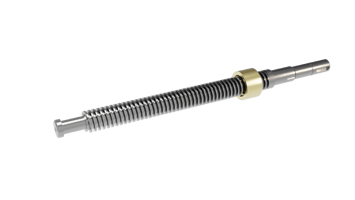Unlock the mechanics behind the robust ACME screw actuator, a pivotal component used in machinery...
Comparing Efficiency: ACME Screws vs Ball Screws in Actuators
Discover the critical differences in efficiency between ACME screws and ball screws in actuator applications, and why your choice matters.
.png?width=1584&height=396&name=Untitled%20design%20(7).png) Understanding the Basics: ACME Screws and Ball Screws
Understanding the Basics: ACME Screws and Ball Screws
ACME screws and ball screws are the most common screws used for linear motion to move loads. ACME screws consist of a screw with trapezoidal threads and a nut that travels on those threads. This screw and nut engagement produces a high amount of frictional losses which yields an efficiency of 20-40%, the range being dependent on the materials used. They are typically applied because of their simplicity and cost-effectiveness. ACME screws are well suited to handle heavy loads and are often used in applications where precision is not as critical.
Ball screws, on the other hand, are designed with a helical raceway that allows ball bearings to circulate between the screw and the nut. This design minimizes friction and enhances efficiency (approaching 90%), making ball screws ideal for high-precision applications. They are more complex and generally more expensive than ACME screws, but their advantages in terms of efficiency and accuracy often justify the cost.
Efficiency Metrics: How ACME and Ball Screws Measure Up
When it comes to efficiency and performance, ball screws tend to outperform ACME screws. The ball bearings in ball screws reduce the friction significantly, allowing for smoother and more precise movements and even higher speeds. This higher efficiency means that less power is required to achieve the same level of performance, which can be a critical factor in energy-sensitive applications. In addition, the higher efficiency of the ball screw allows it to be operated continuously and have a longer expected lifespan than an ACME screw.
While ACME screws are robust and capable of handling heavy loads, they have higher friction and lower efficiency when compared to ball screws. This typically results in an overall lower duty cycle and shorter expected lifespan when compared to a ball screw. However, ACME screws are a better option for applications that are subject to high vibrations. Additionally, ACME screws are well suited for vertical applications, as the nut typically is hard to back drive. In cases such this, a ball screw would require a brake system in order to prevent back driving, and this extra cost must be considered.


Application Scenarios: When to Choose ACME Screws
ACME screws are often chosen for linear actuator applications where cost is a significant factor and high precision is not as critical. They are well-suited for heavy-duty applications where the ability to handle large loads is more important than efficiency. Examples include lifting mechanisms, gates operators, and other industrial machinery where durability and cost-effectiveness are key considerations.
Additionally, ACME screws are less sensitive to contamination from dust and debris, making them a good choice for harsh environments where cleanliness cannot be guaranteed.
Application Scenarios: When to Choose Ball Screws
Ball screws are the preferred choice for linear actuator applications requiring high precision and efficiency. They are commonly used in CNC machinery, robotics, and other applications where accurate positioning and smooth operation are crucial. The reduced friction and higher efficiency of ball screws make them ideal for these high-performance scenarios.
Furthermore, ball screws are often utilized in applications where the actuator must operate continuously over a long period, as their decreased wear and tear result in longer operational lifespans and lower maintenance requirements.
Making the Right Choice for Your Actuator Needs
Choosing between ACME screws and ball screws depends largely on the specific requirements of your application. If cost and load-bearing capacity are your primary concerns, ACME screws may be the better option. However, if your application demands high precision, efficiency, and longevity, then ball screws are likely the superior choice. In either case, RACO can assist in evaluating the application and then recommending the best screw type that will not only optimize performance but also be cost effective.



.png?height=200&name=Untitled%20design%20(62).png)